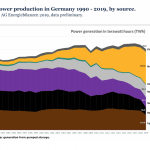Weekly Roundup: A $350 Million Boost for New Antibiotics, a ‘Brain Drain’ Dilemma and an Impact Investing ‘Ghetto’
Development vs. Discovery
Antibiotic resistance – when bacteria change in a way that reduces the effectiveness of medicine – is “one of the biggest threats to global health today,” according to the World Health Organization. So it was kind of a big deal this week when a public-private partnership came up with $350 million to encourage pharmaceutical companies to make new antibiotics.
Or was it?
The partnership, called CARB-X – short for the Combating Antibiotic Resistant Bacteria Biopharmaceutical Accelerator – made a five-year commitment to help bring new drugs to market, basically by incentivizing drug-makers to manipulate known molecules.
That’s fine, at least one expert says, but it doesn’t address the problem of a lack of promising molecules in the first place, Nature reports. “I have mixed feelings about this,” said Kim Lewis, an antibiotics researcher at Northeastern University in Boston, Mass. “I’m really surprised that we are getting another influx of funds into development rather than into discovery.”
Kevin Outterson, CARB-X’s executive director, said that making or finding new compounds is best handled by other funders, adding, “We see ourselves helping to move projects from a university lab towards clinical trials.”
Seems to us that antibiotic resistance, which already kills as many as 700,000 people annually and is expanding, needs all the resources it can get – and the more private players that can be awakened to the challenge, the better.
Are Carbon Producers Really Human Rights Violators?
In what could become a landmark legal case, this week the Commission on Human Rights of the Philippines (CHR) formally accused 47 of the world’s largest carbon-producing companies of violating the human rights of its citizens through their business activity. At issue is the suffering of climate change victims: The complaint has been brought by typhoon survivors and NGOs in a country that has suffered four devastating super-cyclones in the past decade, along with increasingly severe floods and heatwaves that have been linked to global warming. The move is expected to lead to a full legal investigation later this year, in which all 47 companies will be ordered to attend public hearings. Though the CHR can only compel attendance from the 10 with offices in the Philippines, it can seek assistance from the UN to encourage the others to cooperate. According to Zelda Soriano of Greenpeace Southeast Asia, one of the groups participating in the complaint, “The commission’s actions are unprecedented. For the first time, a national human rights body is officially taking steps to address the impacts of climate change on human rights and the responsibility of private actors.”
The CHR has no legal power to compel these companies to reduce their emissions, or penalize them if they don’t. But it is demanding that they explain how climate damage will be “eliminated, remedied and prevented,” and it can make recommendations to the Philippines government and add to the growing global pressure on the industry to address the crisis.
Though it’s impossible not to be sympathetic toward the victims behind this case and their efforts to hold the industry to account, it’s also hard to avoid some ambivalence about their rationale. Fossil fuel companies have certainly made unseemly profits over the years, while engaging in rapacious business practices. They’ve left the public to pay the bill for the damage they’ve caused, and their attempts to deny the link between their products and climate change have been reprehensible. But at the end of the day, they’re extracting these fuels because the vast majority of people around the world – certainly including the Filipinos making this complaint –- depend on them to power their vehicles, manufacture their possessions, cook their food and light their homes. The industry didn’t create this demand, it has simply responded to it. So it’s a little too convenient to lay the entire blame for the climate crisis – and the responsibility to fix it – at the feet of a few dozen corporate villains. To see the real drivers of climate change, we also have to look in the mirror.
24 Ventures Changing the World Through Social Impact Investing. Congrats @OneAcreFund & @RootCapital https://t.co/CXgO2UnJwE #ImpInv
— Skoll Foundation (@SkollFoundation) July 28, 2016
The Ethical Considerations of ‘Brain Drain’
A dilemma posed in this month’s American Medical Association Journal of Ethics highlights how out-of-kilter markets have led to worldwide health care worker “brain drain.”
The case includes all sorts of little-known (at least to us) facts: 25 percent of doctors working in the U.S. got their medical degrees in other countries; according to the World Health Organization, 80 countries have a doctor shortage and the disparity is most pronounced in sub-Saharan Africa; there’s been an increase in doctor emigration to the U.S. in recent years from every sub-Saharan country except South Africa; and the emigration of health care workers costs sub-Saharan Africa an estimated $2.17 billion annually.
The case ponders the responsibility that should be borne by all three “brain drain” players: the health care worker who leaves the country where he was trained to work elsewhere, the resource-scarce country the worker is leaving, and the resource-rich country the worker’s coming to.
It’s hard to fault the international doctors for seeking the position that maximizes their compensation and quality of life – just as it’s hard to fault U.S. doctors who choose not to work in rural areas. It’s not sustainable to base health care systems on people acting heroically.
But the market’s not level, and the question is how to fix it. Are the countries where these emigrating doctors were trained owed commensurate compensation from richer countries that ultimately receive the medical expertise? How can these resource-scarce countries build systems that adequately compensate health care professionals, so they’re not anxious to leave? The case is definitely worth a read and the questions it raises deserve answers, and quickly.
Women Dominate Impact Investing – Is That a Good Thing?
“I looked out, and it was an ocean of women.” That’s how Caprock Group Managing Director Matthew Weatherley-White describes the experience (unusual in the male-dominated financial services sector) of speaking at a recent impact investing event. In a thought-provoking article in the publication Financial Planning discussing women’s dominant role in the sector, Weatherley-White and others wonder if this dominance is necessarily a positive. As the headline puts it, rather provocatively, has impact investing become an “opportunity or ghetto” for the women who lead and work in it?
As Weatherley-White describes it, ghettos can be havens where people find mutual support from like-minded peers – and so far, impact investing has provided that environment for women. “Women are drawn to the broader responsible social conversation,” he says. “It’s been a place where their voices are heard. They can work, raise assets and start companies.” But a ghetto can also become a place where less-powerful groups are cordoned off from the broader community, separate but unequal. Until impact investing becomes mainstream and overcomes the industry’s assumption that it under-emphasizes profits, Weatherley-White cautions, the sector will remain “cloistered” – along with the women who lead it.
In building #socent, must we always design for scale? @teresachahine shares both sides of the debate: https://t.co/1c6F9SVDVv via @HuffPost
— Acumen (@Acumen) July 29, 2016
Tall Tales: A Development Problem in Developing Countries
We probably spent more time than we should have this week perusing the most comprehensive study of human height ever conducted. Led by scientists from Imperial College London, it included data from 1914 to 2014 (and a really cool infographic).
Interesting tidbit: Dutch men and Latvian women are currently the tallest in the world; East Timor men and Guatemalan women are the shortest.
Concerning tidbit: Several developing countries in sub-Saharan Africa, North Africa and the Middle East have seen a decline in average height over the past three to four decades. This a problem because, according to Imperial College’s news site, “children and adolescents who are better nourished and live in better environments tend to be taller, and height may even be influenced by a mother’s health and nutrition during pregnancy. It has lifelong consequences for health and even education and earnings. Some research suggests people who are taller tend to live longer, gain a better education and even earn more.”
Global health is on the uptick overall, but there are still problems in emerging economies, like stunting and maternal health, in search of solutions.
Africa: The Mobile Continent
It’s no secret that mobile access is transforming Africa. This week, a new GSMA report brought that picture more fully into focus. A few takeaways:
- The continent has over half a billion mobile users, amounting to 46 percent of the population. In the next five years, subscribers will total 725 million.
- The mobile ecosystem added $153 billion to Africa’s economy in 2015, equalling 6.7 percent of its GDP and generating 3.8 million jobs. This is projected to increase to $214 billion (or 7.6 percent of GDP) and 4.5 million jobs by 2020.
- Though mobile broadband connections amounted to just over a quarter of total connections in 2015, they will grow to 60 percent by 2020. Meanwhile, the number of smartphone connections has almost doubled in the past two years, reaching 226 million (a quarter of total connections in the region). And these numbers will more than triple in the next five years.
Not all the news was positive, though, as the report cautioned that “subscriber growth rates are now beginning to slow and will increasingly converge with the global average, as affordability challenges become a key barrier.” Even so, it’s abundantly clear (if it wasn’t already) that Africa’s future is mobile, and that this reality will power entrepreneurship. According to the GSMA, the continent now has about 310 active tech hubs, including 180 accelerators or incubators. And mobile operators are actively supporting this ecosystem through open APIs that enable the development of new services in areas like messaging, billing, location and mobile money, allowing startups to scale quickly. The next five years should be very interesting.
Photo: Colorized scanning electron micrograph of a white blood cell interacting with an antibiotic resistant strain of Methicillin-Resistant Staphylococcus aureus (MRSA). Credit: NIAID, via Flickr.
- Categories
- Environment, Health Care, Investing



